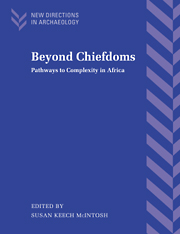Book contents
- Frontmatter
- Contents
- List of figures
- List of tables
- List of contributors
- Preface
- 1 Pathways to complexity: an African perspective
- 2 The segmentary state and the ritual phase in political economy
- 3 Perceiving variability in time and space: the evolutionary mapping of African societies
- 4 Western representations of urbanism and invisible African towns
- 5 Modeling political organization in large-scale settlement clusters: a case study from the Inland Niger Delta
- 6 Sacred centers and urbanization in West Central Africa
- 7 Permutations in patrimonialism and populism: The Aghem chiefdoms of Western Cameroon
- 8 Wonderful society: the Burgess Shale creatures, Mandara polities, and the nature of prehistory
- 9 Material culture and the dialectics of identity in the Kalahari: AD 700–1700
- 10 Seeking and keeping power in Bunyoro-Kitara, Uganda
- 11 The (in)visible roots of Bunyoro-Kitara and Buganda in the Lakes region: AD 800–1300
- 12 The power of symbols and the symbols of power through time: probing the Luba past
- 13 Pathways of political development in equatorial Africa and neo-evolutionary theory
- Index
6 - Sacred centers and urbanization in West Central Africa
Published online by Cambridge University Press: 14 October 2009
- Frontmatter
- Contents
- List of figures
- List of tables
- List of contributors
- Preface
- 1 Pathways to complexity: an African perspective
- 2 The segmentary state and the ritual phase in political economy
- 3 Perceiving variability in time and space: the evolutionary mapping of African societies
- 4 Western representations of urbanism and invisible African towns
- 5 Modeling political organization in large-scale settlement clusters: a case study from the Inland Niger Delta
- 6 Sacred centers and urbanization in West Central Africa
- 7 Permutations in patrimonialism and populism: The Aghem chiefdoms of Western Cameroon
- 8 Wonderful society: the Burgess Shale creatures, Mandara polities, and the nature of prehistory
- 9 Material culture and the dialectics of identity in the Kalahari: AD 700–1700
- 10 Seeking and keeping power in Bunyoro-Kitara, Uganda
- 11 The (in)visible roots of Bunyoro-Kitara and Buganda in the Lakes region: AD 800–1300
- 12 The power of symbols and the symbols of power through time: probing the Luba past
- 13 Pathways of political development in equatorial Africa and neo-evolutionary theory
- Index
Summary
Introduction
The concept of civilization was for a long time defined in terms of the presence or absence of what was considered to be key elements, such as writing. It is now generally accepted that civilization can exist without the presence of writing, which Gordon Childe had taken for the one ingredient that usually marked the turning point (Childe 1950, quoted in Connah 1987: 7). Many scholars have made the point that these definitions were based on a limited knowledge of other parts of the world, especially Africa.
Like civilization, the concept of urbanization has for a long time been pervaded by Western representations. Common to most of the early theories about the nature of a town or city is the belief that the existence of an agricultural population, a mercantile class, and writing were a prerequisite. Also considered as necessary was the idea that the settlement had to perform the functions of a religious and an administrative center, capable of mobilizing a massive labor force for monumental architecture and the accumulation of wealth (Hassan 1993; R.McIntosh, this volume; O'Connor 1993).
Long-distance trade and religion have indeed influenced the growth of towns in some parts of the world. The rise of the mercantile towns of East Africa, for example, was influenced by Portuguese and Arab trade during the sixteenth and se venteenth centuries. Similarly, the Islamic towns of North Africa, with their sultanates, mosques, Islamic schools, and wall enclosures, testify to strong Islamic influence in this part of the continent prior to European colonization.
- Type
- Chapter
- Information
- Beyond ChiefdomsPathways to Complexity in Africa, pp. 80 - 87Publisher: Cambridge University PressPrint publication year: 1999
- 7
- Cited by



